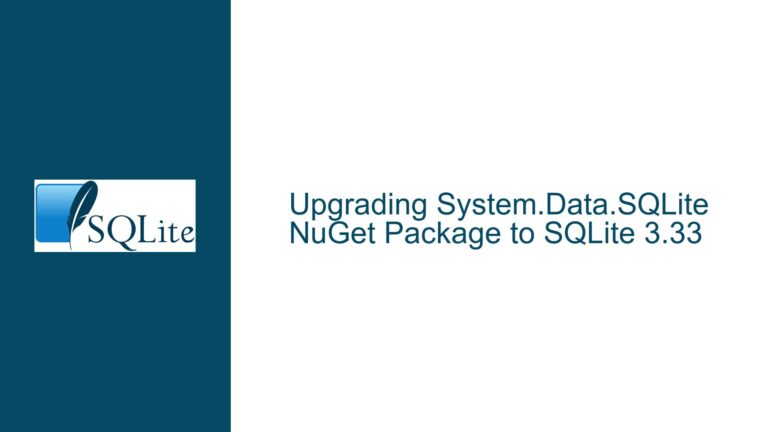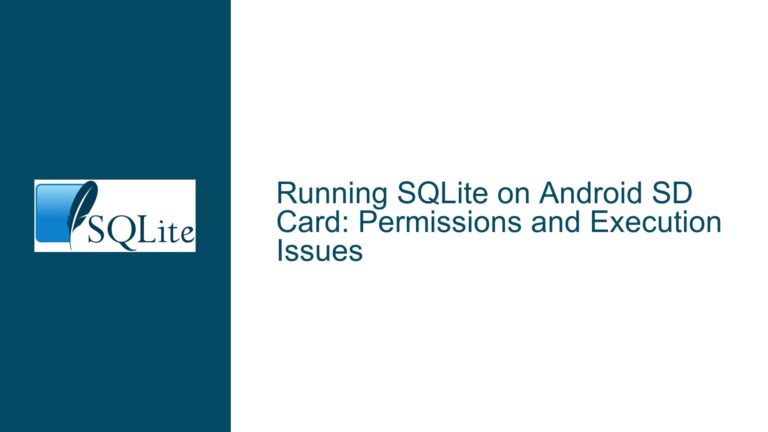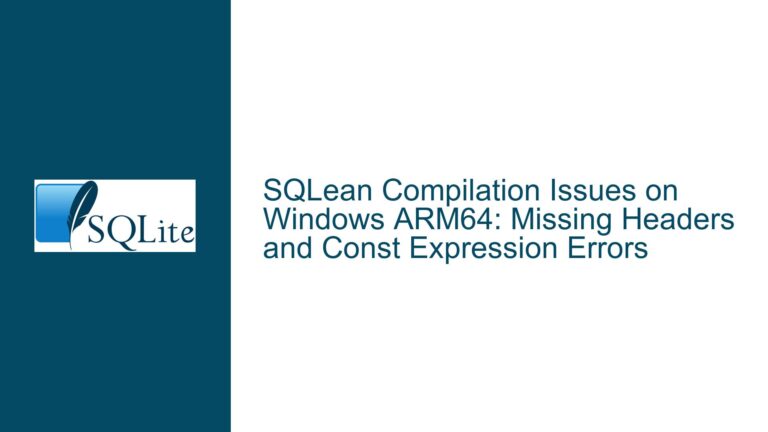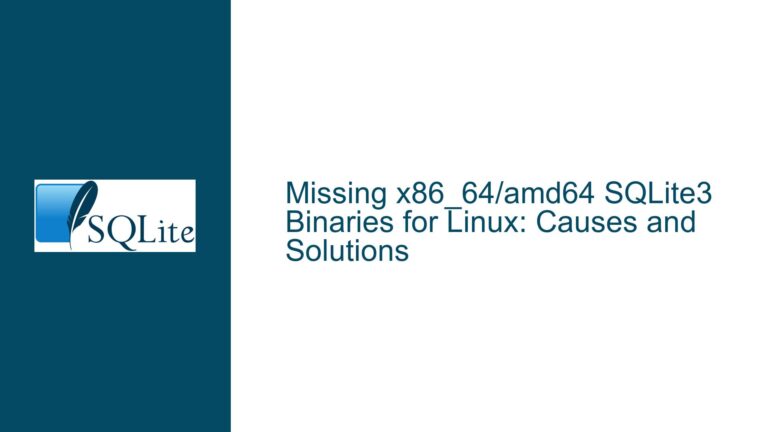Unexpected UPDATE Authorizer Triggers When Using json_each in SQLite
Understanding json_each-Induced sqlite_master Updates in SQLite Authorizer Contexts
Issue Overview: json_each Virtual Table Creation Mistakenly Flags Authorizer Updates
When employing the json_each function in SQLite queries, particularly in versions prior to 3.41.0, the SQLite authorizer callback may report unexpected UPDATE operations on the sqlite_master system table. This occurs despite the query being a SELECT operation, which should inherently be read-only. The root of this behavior lies in the internal mechanics of virtual table creation for json_each and how older SQLite versions interact with the authorizer during this process.
The sqlite_master table is SQLite’s schema storage, cataloging all database objects (tables, indexes, views, etc.). When a virtual table like json_each is instantiated during query execution, SQLite historically performed transient schema modifications that triggered UPDATE authorizer checks. These checks are intended to monitor persistent schema changes but were erroneously activated during ephemeral virtual table setup. The authorizer, when configured to restrict operations to SELECT/READ, interprets these transient UPDATE actions as violations, leading to operational blockages or errors.
The problem manifests in scenarios where applications enforce strict access controls via the authorizer. For instance, a PHP application using SQLite3::setAuthorizer to limit database interactions to read operations would encounter authorization failures when json_each is involved. This is counterintuitive because json_each is designed for JSON data traversal without side effects. The discrepancy arises from the virtual table’s internal setup process, which in older SQLite versions, involved temporary schema metadata adjustments that the authorizer misinterprets as legitimate UPDATE operations.
Key Factors Leading to Erroneous Authorizer UPDATE Triggers
Virtual Table Initialization Overhead in Older SQLite Versions
Prior to version 3.41.0, SQLite’s virtual table mechanism forjson_eachinvolved a setup process that temporarily modified schema metadata insqlite_master. These modifications were part of SQLite’s internal bookkeeping for virtual tables but were never intended to persist. However, the authorizer, unaware of the transient nature of these changes, reported them asUPDATEoperations. This behavior stemmed from how virtual tables were registered in the schema cache during their creation.Authorizer Callback Scope and Granularity
The SQLite authorizer callback (sqlite3_set_authorizer) monitors all database operations, including low-level actions like accessing specific columns or modifying schema entities. Whenjson_eachis parsed, SQLite prepares a virtual table structure, which in older versions required updating internal schema representations. The authorizer, depending on its configuration, might intercept these operations asSQLITE_UPDATEactions onsqlite_master, even though no persistent changes occur.Version-Specific Fixes in SQLite’s Virtual Table Handling
The resolution, introduced in SQLite 3.41.0 (via check-in eed1e030722deb24), refined how virtual tables likejson_eachinteract with the schema cache. This update eliminated unnecessarysqlite_masterupdates during virtual table initialization, thereby aligning the authorizer’s behavior with the expected read-only nature ofjson_eachqueries. Applications running on versions prior to 3.41.0 remain susceptible to this issue unless mitigated through alternative strategies.
Resolving json_each-Related Authorizer Conflicts: Version Upgrades and Workarounds
Step 1: Confirm SQLite Version Compatibility
Begin by verifying the SQLite version in use. Execute SELECT sqlite_version(); or check the version string through your application’s API (e.g., SQLite3::version() in PHP). If the version is below 3.41.0, the issue is likely present. Upgrading to SQLite 3.41.0 or later is the most straightforward solution, as it addresses the root cause. For environments where upgrading is impractical (e.g., embedded systems, legacy applications), proceed to Step 2.
Step 2: Implement Temporary Table Isolation for json_each Operations
To circumvent the authorizer’s false positives, decouple the json_each invocation from user-controlled queries. Create a temporary table that materializes the JSON-evaluated data, then direct user queries to this intermediary table. This approach confines json_each usage to a controlled setup phase, shielding user queries from the virtual table’s internal schema interactions.
Example Workflow:
- Create Temporary Table:
CREATE TEMP TABLE IF NOT EXISTS temp_json_data ( id INTEGER PRIMARY KEY, key TEXT, value TEXT, document TEXT ); - Populate Temporary Table Using json_each:
INSERT INTO temp_json_data SELECT a.id, j.key, j.value, a.document FROM main_table a, json_each(a.document, '$.path') AS j; - Execute User Queries Against Temporary Table:
SELECT * FROM temp_json_data WHERE json_extract(document, '$.field') = 'value';
By isolating json_each within the temporary table population, the authorizer only encounters standard SELECT operations during user query execution, avoiding sqlite_master UPDATE triggers.
Step 3: Adjust Authorizer Logic to Whitelist Temporary Schema Operations
If temporary table creation itself triggers authorizer violations, extend the authorizer callback to conditionally allow schema modifications prefixed with TEMP_ or targeting the temp schema. For example, in PHP:
$db->setAuthorizer(function ($action, $arg1, $arg2, $arg3, $arg4) {
if ($action === SQLite3::UPDATE && $arg3 === 'temp') {
return SQLite3::OK;
}
// Existing logic for other operations
});
This exemption permits temporary table operations while maintaining strict controls on the main database schema.
Step 4: Backport SQLite Fix to Custom Builds (Advanced)
For mission-critical systems requiring older SQLite versions, consider backporting the fix from check-in eed1e030722deb24. This involves modifying the virtual table initialization logic to skip sqlite_master updates during json_each setup. Note that this requires familiarity with SQLite’s internals and C programming.
Step 5: Monitor and Test Authorizer Behavior
After implementing workarounds, rigorously test the application with the authorizer enabled. Use SQLite’s .auth on CLI command or equivalent debugging output to ensure no unauthorized operations persist. For PHP, the example code’s printf statements within the authorizer callback serve this purpose, logging all non-READ/SELECT actions for review.
Conclusion
The interaction between SQLite’s authorizer and virtual table mechanisms in pre-3.41.0 versions introduces unintended UPDATE triggers during json_each usage. By upgrading SQLite, employing temporary tables, or adjusting authorizer logic, developers can mitigate these issues while maintaining secure, read-only query environments. For legacy systems, a combination of isolation techniques and targeted authorizer exemptions provides a robust solution without compromising operational integrity.






